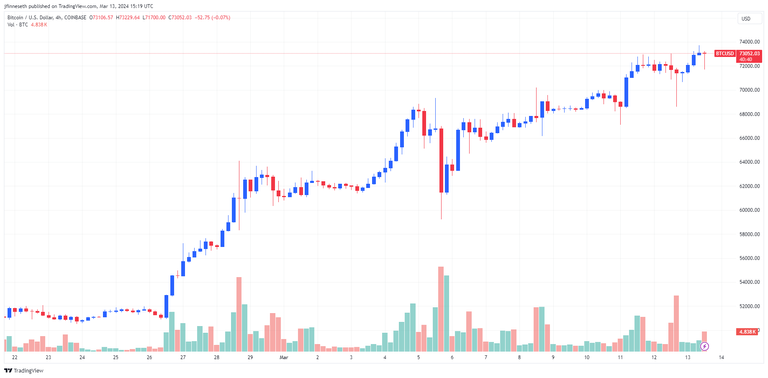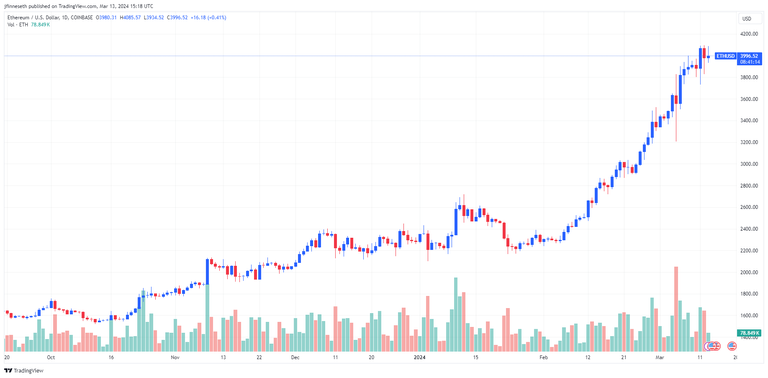[ad_1]
Bitcoin (BTC) notched another new all-time high in the early hours on Wednesday, topping out at $73,725 on Coinbase before a multi-hour sell-off dropped it to a low of $71,700.
The choppy price action continues to wreak havoc in the derivatives market, with data from CoinGlass showing that over the past 24 hours, $228.6 million worth of long positions and $127.6 million in short positions were liquidated across exchanges.
Spot BTC exchange-traded funds (ETF) remain the primary source of demand, putting a floor under the price of Bitcoin as evidenced by the fact that every time it starts to experience a sell-off, the top crypto is almost immediately bid back up as various entities scoop up any available BTC on the open market.

BTC/USD Chart by TradingView
As highlighted by X user TedTalksMacro in the following tweet, flows into spot BTC ETFs continue to increase by the day, soaking up the available liquidity and putting the market on a steady path to $100,000 Bitcoin.
Fund inflows like we have never seen before.
It makes 2020 look small… price will continue to catch up over the coming months.
The steady grind to 100k is underway #BTC
Historically, when these flows peak, theres 2-3 months to GTFO of the market. pic.twitter.com/I3a6binvEH
— ted (@tedtalksmacro) March 13, 2024
During previous bull market cycles, significant price increases were typically followed by an extended period of consolidation that saw Bitcoin’s price drift lower while traders rotated into altcoins.
This time around, the BTC pullbacks are brief, but the same rotation into altcoins is occurring, creating a unique experience where Bitcoin is in bull market mode at the same time as altseason ramps up.
And things could continue to escalate from here as Bitcoin is approaching a supply-side crisis, according to Ki Young Ju, co-founder and CEO of analytics platform CryptoQuant.
Bears can’t win this game until spot #Bitcoin ETF inflow stops.
Last week, spot ETFs saw netflows of +30K BTC. Known entities like exchanges and miners hold around 3M BTC, including 1.5M BTC by US entities.
At this rate, we’ll see a sell-side liquidity crisis within 6 months. pic.twitter.com/qwAbZJwSOl
— Ki Young Ju (@ki_young_ju) March 12, 2024
In a follow-up post, Ju noted that “Bitcoin is currently in the price discovery phase,” and said, “Once a sell-side liquidity crisis happens, its next cyclical top may exceed our expectations due to limited sell-side liquidity and thin orderbook.”

“This could occur once accumulation addresses reach around a totalidade of 3M BTC,” Ju said.
When it comes to the performance of the altcoin market, Ethereum (ETH) has been helping to drive prices higher in recent weeks as the second-ranked crypto by market cap prepared to undergo its latest upgrade – the Dencun upgrade – which was successfully integrated into the Ethereum mainnet early on Wednesday.
Anticipation for the upgrade helped provide a boost to Ether price since early February, but the rally stalled out near resistance at $4,100, the last major resistance level below its all-time high of $4,870.

ETH/USD Chart by TradingView
Dencun is expected to help reduce the cost of transacting on layer-two networks like Arbitrum, Optimism, and Polygon.
“The Dencun Upgrade represents a giant leap forward in scaling resilience and performance for the Ethereum ecosystem,” said Mara Schmiedt, CEO of Alluvial, in a note shared with Kitco Crypto.
“Ethereum has faced scalability issues that have acted as a blocker to mainstream adoption and accommodating the growing number of users and transactions,” she said. “In light of Bitcoin’s recent institutional surge enabled by recent ETF spot market approvals and totalidade value locked in Ethereum’s DeFi ecosystem close to scratching the $100bn mark, this scalability-focused upgrade is much anticipated.
“The combination of Ethereum’s rollup-centric scalability model, the upcoming Dencun upgrade, and the rapid proliferation and transaction growth on L2 points to an optimistic future,” Schmiedt said. “Scalability is just one side of the equation, though. In order to reach mainstream adoption, meaningful institutional adoption, widespread accessibility, and clear regulatory frameworks are all necessary factors.”
Disclaimer: The views expressed in this article are those of the author and may not reflect those of Kitco Metals Inc. The author has made every effort to ensure accuracy of information provided; however, neither Kitco Metals Inc. nor the author can guarantee such accuracy. This article is strictly for informational purposes only. It is not a solicitation to make any exchange in commodities, securities or other financial instruments. Kitco Metals Inc. and the author of this article do not accept culpability for losses and/ or damages arising from the use of this publication.
[ad_2]


